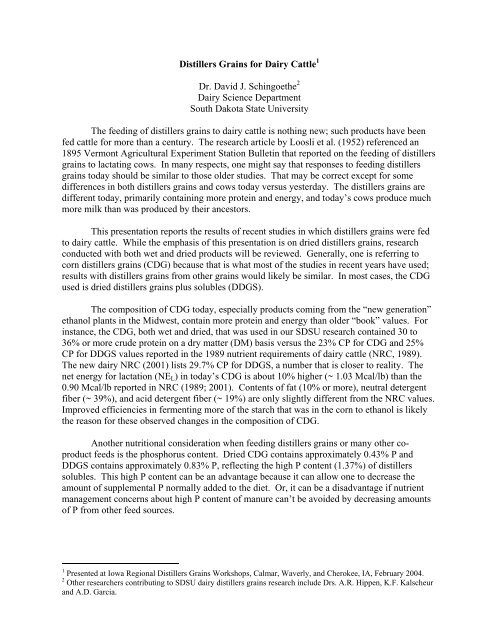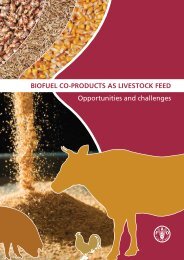Distillers Grains Feeding Recommendations. - Distillers Grains By ...
Distillers Grains Feeding Recommendations. - Distillers Grains By ...
Distillers Grains Feeding Recommendations. - Distillers Grains By ...
You also want an ePaper? Increase the reach of your titles
YUMPU automatically turns print PDFs into web optimized ePapers that Google loves.
<strong>Distillers</strong> <strong>Grains</strong> for Dairy Cattle 1Dr. David J. Schingoethe 2Dairy Science DepartmentSouth Dakota State UniversityThe feeding of distillers grains to dairy cattle is nothing new; such products have beenfed cattle for more than a century. The research article by Loosli et al. (1952) referenced an1895 Vermont Agricultural Experiment Station Bulletin that reported on the feeding of distillersgrains to lactating cows. In many respects, one might say that responses to feeding distillersgrains today should be similar to those older studies. That may be correct except for somedifferences in both distillers grains and cows today versus yesterday. The distillers grains aredifferent today, primarily containing more protein and energy, and today’s cows produce muchmore milk than was produced by their ancestors.This presentation reports the results of recent studies in which distillers grains were fedto dairy cattle. While the emphasis of this presentation is on dried distillers grains, researchconducted with both wet and dried products will be reviewed. Generally, one is referring tocorn distillers grains (CDG) because that is what most of the studies in recent years have used;results with distillers grains from other grains would likely be similar. In most cases, the CDGused is dried distillers grains plus solubles (DDGS).The composition of CDG today, especially products coming from the “new generation”ethanol plants in the Midwest, contain more protein and energy than older “book” values. Forinstance, the CDG, both wet and dried, that was used in our SDSU research contained 30 to36% or more crude protein on a dry matter (DM) basis versus the 23% CP for CDG and 25%CP for DDGS values reported in the 1989 nutrient requirements of dairy cattle (NRC, 1989).The new dairy NRC (2001) lists 29.7% CP for DDGS, a number that is closer to reality. Thenet energy for lactation (NE L ) in today’s CDG is about 10% higher (~ 1.03 Mcal/lb) than the0.90 Mcal/lb reported in NRC (1989; 2001). Contents of fat (10% or more), neutral detergentfiber (~ 39%), and acid detergent fiber (~ 19%) are only slightly different from the NRC values.Improved efficiencies in fermenting more of the starch that was in the corn to ethanol is likelythe reason for these observed changes in the composition of CDG.Another nutritional consideration when feeding distillers grains or many other coproductfeeds is the phosphorus content. Dried CDG contains approximately 0.43% P andDDGS contains approximately 0.83% P, reflecting the high P content (1.37%) of distillerssolubles. This high P content can be an advantage because it can allow one to decrease theamount of supplemental P normally added to the diet. Or, it can be a disadvantage if nutrientmanagement concerns about high P content of manure can’t be avoided by decreasing amountsof P from other feed sources.1 Presented at Iowa Regional <strong>Distillers</strong> <strong>Grains</strong> Workshops, Calmar, Waverly, and Cherokee, IA, February 2004.2 Other researchers contributing to SDSU dairy distillers grains research include Drs. A.R. Hippen, K.F. Kalscheurand A.D. Garcia.
















